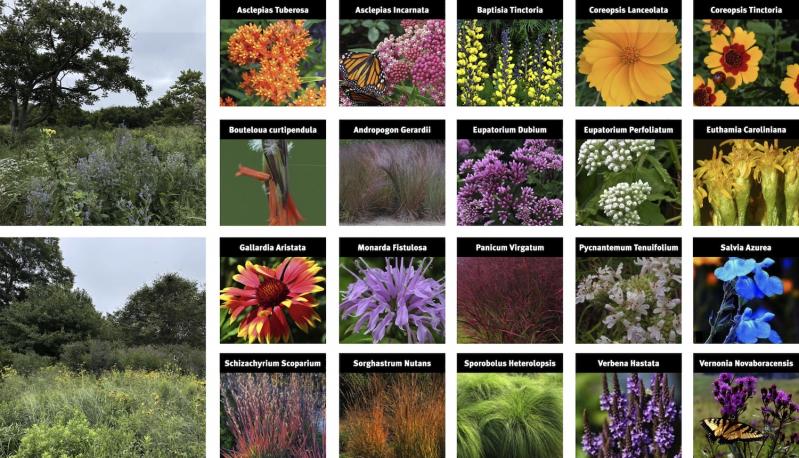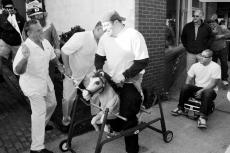ChangeHampton, a community organization that promotes biodiverse and sustainable landscaping practices, was in front of the East Hampton Town Board last week presenting updated plans for a grassland pollinator meadow at Town Hall and Justice Court. The group also sought to amend licensing and working agreements.
Before members spoke about their plans, however, Leonard Green, a co-founder of the group, used the public portion of the meeting to inveigh against invasives, specifically miscanthus, an ornamental grass.
“Take a walk in the Grace Estate,” he told the board. “It’s protected, preserved land, but unfortunately its protected status has not protected it from miscanthus,” he said, using the Latin name for what’s commonly known as Chinese silvergrass. “This is a popular non-native grass that you see everywhere, and it escapes; it doesn’t stay on your property.”
When we talk of history on the East End, we think of buildings, boats, and windmills, but nature has its own parallel history. Among the working windmills and grazing sheep in 18th-century East Hampton, there were fields of bluestem, switchgrass, and Indian grass. Miscanthus? Nope.
If ChangeHampton has its way, and the town board seemed quite supportive, the group will soon make changes to the mowed lawn now surrounding Town Hall, in what will seem like an extension of the successful pollinator garden for which ground was broken in October 2022. By 2027, members hope, a meadow, which will be planted in stages over the next year and a half, will be established, with more native grasses than flowers.
“Some days it’s hard for us to believe that we began with a 400-square-foot turf lawn and one dying beech tree,” Gail Pellett, a ChangeHampton co-founder, said.
She bemoaned the staggering loss of birds and insects in recent decades, due largely to habitat loss and pesticide use. “We’re trying to model a healthier approach. Planting more natives, while inviting wildlife and pollinators, linking ecological health with human health.”
The grassland has been designed by Abby Clough Lawless, owner of Farm Landscape Design. Ms. Lawless also designed the beloved pollinator garden.
“She has delivered a captivating design which can be read as one big meadow with pathways and access points, or a series of meadows that will feature different ratios of grasses to pollinator-friendly perennials with an emphasis on their ecological services to bring back birds, bees, butterflies, and beneficial insects to the Town Hall campus,” said Stephan Van Dam, a co-founder of ChangeHampton.
That means short meadows, tall meadows, fern gardens under shady trees, with educational signage all within sight of Route 27, and even “a ring of native shrubs to hide the A.C. unit,” Mr. Van Dam said. No green giants here. In front of Town Hall, a dense planting of panicum, or switchgrass, will shield the already established pollinator garden from traffic and create a sense of place.
Eight-and-a-half-foot-wide swaths of grass will connect one meadow to the next, with the Bill King sculpture “Nureyev & Fontaine,” placed in 2018, as its center. In this section, across the drive from Town Hall, 70 percent of the plants will be grasses and 30 percent will be perennials.
The group hopes to plant a cluster of donated oak trees before Thanksgiving. “They’re the greatest keystone species in our region,” Mr. Van Dam said. An oak tree is the host plant for hundreds of caterpillar species. “We want to educate the community that instead of cutting them down we need to be planting them. We want to counteract the disturbing collapse of bird species that rely on the caterpillars to raise their offspring.”
According to a Douglas Tallamy article in The New York Times titled “The Chickadee’s Guide to Gardening,” the little birds need 6,000 to 9,000 caterpillars to feed their young before they can fledge.
ChangeHampton has received grants from the New York Community Trust and the J.M. Kaplan Fund to build and maintain the gardens. The group also relies on faithful volunteers.
“The ultimate goal is to contribute to East Hampton Town becoming a model of healthy, biodiverse, resilient landscaping for other towns in Suffolk County and Long Island to emulate,” Mr. Van Dam said.
“It’s one thing to think big and dream, but you guys have shown an ability to make it happen,” Councilman Ian Calder-Piedmonte said.
“It’s been an extraordinary working relationship,” agreed Supervisor Kathee Burke-Gonzalez. She spoke highly of the pollinator garden. “I can’t tell you the countless conversations I’ve had with people coming and going into this building. We have brides in there getting their photos taken with photographers. Now that we’re going to get these meadows, we’re really proud to come here to work.”




